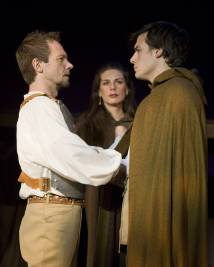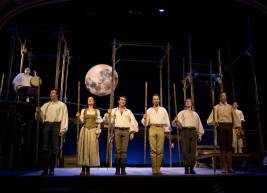
If you’re an avid musical-theatergoer like this reviewer, you’ve probably seen at least one production of Lerner & Loewe’s Camelot that made you think, “Bo-ring.” Then there are those Camelots that feature a 60something King Arthur, forgetting that Richard Burton was but 35 when he originated the role on Broadway and Richard Harris all of 36 when he made the movie. Dozens of lords, ladies, and “simple folk” in 6th Century garb may be gorgeous to look at (the original Broadway production of Camelot had a cast of 55!), but they have tended to bog down Camelot’s romantic triangle under the weight of all those costumes. Besides, what theater can afford a cast of even 25 these days?
Director David Lee has solved all these problems in an all-around mesmerizing downsizing of Camelot at the Pasadena Playhouse. A young and virile Arthur, a gifted cast grand-totaling 8, and nary a dull moment make this quite possibly the most powerful and enthralling Camelot ever.
At heart, Camelot has always been a love story, or rather three love stories—Arthur and Guinevere, Guinevere and Lancelot, and (though admittedly platonic) Arthur and Lancelot. The brilliance of Lee’s vision is that for the first time in my experience, there are high emotional stakes. The love that unites each of the lead characters is so deeply felt by all three that it’s nigh-on impossible as an audience member not to become invested in the impossible wish that somehow, some way, none of them will get hurt. For the first time, Camelot is not just a bunch of beautiful songs by the Tony-winning duo who wrote My Fair Lady. It’s passionate, gripping theater of the highest order.
It’s also about as imaginative a musical revival as you’re likely to see this year.
Eschewing the literal scenic designs of Camelots past (and the many set changes they require), Tom Buderwitz has created a kind of ancient wooden scaffolding that transforms itself into the play’s many locales with theater’s most magic ingredient—imagination. We don’t need a castle. There’s a framed painting hanging from the scaffolding which situates us there. We don’t need a forest of trees. An actor holds up a branch and our imagination does the rest. To show that Arthur has fallen from the tree where he’s been observing Guinevere for the first time, another actor simply breaks a stick in half, which we imagine to be the branch Arthur has been sitting on.
Alan Jay Lerner still gets full credit for Camelot’s book, but clearly director Lee has had a major hand in revising and reshaping it. A lengthy opening sequence between Arthur and Merlin is gone (as is Merlin), allowing Arthur to break the fourth wall from the get-go and begin his tale. In “I Wonder What The King Is Doing Tonight,” Arthur reflects on both his royal subjects and his upcoming wedding to a woman he’s never met. Audience applause has scarcely died down when Guinevere makes her entrance with “The Simple Joys Of Maidenhood,” and for Arthur it’s clearly love at first sight. It’s the same for Guinevere, and with Shannon Stoeke and Shannon Warne as King and future Queen, it’s obvious why each would be attracted to the other. We feel their immediate connection, the magic of their first meeting, and this makes Guinevere’s and Lancelot’s inexorable path to love all the more heartbreaking. Never before has there been a Camelot which so invests the audience in the fate of its trio of leads.
Unlike the instant spark that unites King and soon-to-be bride from first meeting, Guinevere and Lancelot’s initial rapport is in the grand romantic tradition of hate at first sight—which we realize from the start is just two people trying to deny their attraction for each other. It’s certainly easy to see why Lance might rub Ginny the wrong way. This too-handsome-for-his-own-good Frenchman is simply too full of himself, and (in a clever aside to the audience), confesses to us, “I’m irritating. I always have been.”
Anyone familiar with the legend of King Arthur knows how Camelot will end, but for the first time (at least in my experience), the love and the pain felt by King, Queen, and Knight are palpable. At last we have a love story that merits the gorgeous melodies of and the witty lyrics of Lerner & Lowe.
And a gorgeous set of songs they are, beginning with the title tune, followed by “How To Handle A Woman,” Before I Gaze At You Again,” “I Loved You Once In Silence,” and of course, “If Ever I Would Leave You.”
Both Shannons Stoeke and Warne appeared in the 2007 Michael York tour, he as Mordred and she as Nimue (understudying Guinevere). Here they get the roles they deserve, and the audience is the beneficiary.
Stoeke is by far the best Arthur I’ve ever seen—charming, virile, shy, intelligent, tormented, love-struck, and young. In addition, he sings Arthur’s songs in a beautiful tenor that makes one wish that there was a cast recording or soundtrack of them sung the way they should be, the way they are here. Warne matches him every step of the way as Arthur’s spunky, dazzling bride, singing in a glorious soprano and demonstrating fierce acting chops. There couldn’t be a better Lancelot than Doug Carpenter, L.A. musical theater’s premier romantic lead. Delightfully full of himself, Carpenter’s Lancelot is the prig you can’t help but like, and vocally, there’s no baritone with richer pipes.
As the Sirs (Lionel, Dinanan, and Sagramore), Zachary Ford, Richard R. Segall, and Andrew Ross Wynn are three strikingly different physical types, just what the roles require. What they have in common are fine voices and terrific comic chops, which they demonstrate opposite Warne in “Then You May Take Me To The Fair,” one of Camelot’s lightest, brightest moments. Fresh-faced L.A. newcomer Will Bradley shines in a pair of roles, as the elderly Dap and more particularly as Arthur’s devious bastard son Mordred. “The Seven Deadly Virtues,” Mordred’s sly salute to vice, makes it perfectly clear that this is not a man to be trusted, and thankfully the song has not been cut as it was from the tour. Completing the cast is its youngest member, Seth Daly, doing fine work as young Tom, assigned by his King to tell the tale of Camelot. Merlin, Nimue, King Pellinore, and Morgan le Fey have been cut from this production at no great loss.
Among the evening’s most memorable sequences are Arthur’s flashback to the story of The Sword In The Stone; an exciting and ingeniously staged jousting competition; Arthur and Guinevere’s last-ditch effort to bring back the gaiety that’s been missing from their marriage (“What Do The Simple Folk Do?”); and the thrilling trial, sentencing and escape of Lancelot and Guinevere to the strains of “Guinevere.” What makes these sequences work so well is that, like so much in the production, they rely on the audience’s ability to imagine. Any quibbles I might have with Lee’s staging are so minor as to not merit mentioning.
There’s not a lot of dancing per se, but stage movement has been stylishly choreographed by Mark Esposito. Music director Christy Crowl has gotten standout vocal performances from her cast, and expertly conducts the production’s 13-piece orchestra from the pit.
Maggie Morgan’s costumes are considerably less opulent than what we’ve seen in previous Camelots, but entirely fitting the mood established by Lee and company. Michael Gilliam’s lighting is often quite spectacular—and highly effective. Thumbs up to to Vikram Kirby’s sound design.
Having loved Lee’s re-envisioning of Cole Porter’s Can-Can a few years back, and being familiar with most of the cast, I went to Camelot with high expectations. Those expectations were met, and then some. David Lee’s Camelot is a thrilling new musical theater experience, one which brings a creaky 1960s production into the new century. After experiencing this brilliant revisal, I can’t imagine it being done any other way.
Pasadena Playhouse, 39 South El Molino Ave., Pasadena.
www.pasadenaplayhouse.org
–Steven Stanley
January 20, 2010
Photos: Craig Schwartz




 Since 2007, Steven Stanley's StageSceneLA.com has spotlighted the best in Southern California theater via reviews, interviews, and its annual StageSceneLA Scenies.
Since 2007, Steven Stanley's StageSceneLA.com has spotlighted the best in Southern California theater via reviews, interviews, and its annual StageSceneLA Scenies.







 COPYRIGHT 2024 STEVEN STANLEY :: DESIGN BY
COPYRIGHT 2024 STEVEN STANLEY :: DESIGN BY